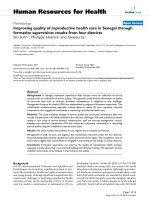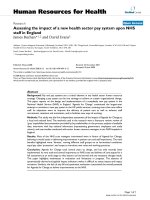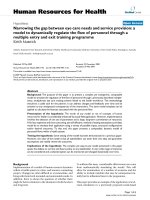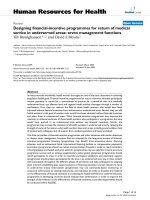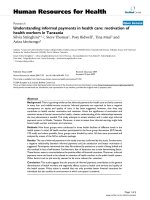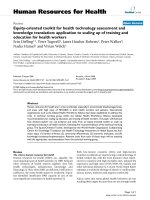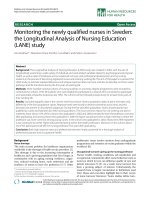báo cáo sinh học:" Narrowing the gap between eye care needs and service provision: the service-training nexus" pdf
Bạn đang xem bản rút gọn của tài liệu. Xem và tải ngay bản đầy đủ của tài liệu tại đây (282.9 KB, 9 trang )
BioMed Central
Page 1 of 9
(page number not for citation purposes)
Human Resources for Health
Open Access
Methodology
Narrowing the gap between eye care needs and service provision:
the service-training nexus
Keith Masnick
Address: School of Public Health and Community Medicine, University of New South Wales, Kensington, New South Wales, Australia
Email: Keith Masnick -
Abstract
Background: The provision of eye care in the developing world has been constrained by the
limited number of trained personnel and by professional cultures. The use of personnel with
specific but limited training as members of multidisciplinary teams has become increasingly
important as health systems seek to extract better value from their investments in personnel.
Greater positive action is required to secure more efficient allocation of roles and resources. The
supply of professional health workers is a factor of the training system, so it stands to reason that
more cost-effective, flexible and available education methods are needed. This paper presents a
highly flexible competencies-based multiple entry and exit training system that matches and adapts
training to the prevailing population and service needs and demands, while lifting overall standards
over time and highlighting the areas of potential benefit.
Methods: Literature surveys and interviews in five continents were carried out. Based on this and
the author's own experience, a encies-based multiple entry and exit scheme for eye care in a
developing country was derived, modeled and critically reviewed by interested parties in one
country.
Results: The scheme was shown to be highly cost-effective and readily adaptable to the anticipated
eye care needs of the population. Eye care players in one selected country have commented
favourably on the scheme.
Conclusion: The underlying principles used to derive this model can be applied to many eye care
systems in many developing countries. The model can be used in other disciplines with similar
constructs to eye care.
Background
A huge and growing burden
The worldwide number of visually impaired persons,
according to current World Health Organization (WHO)
definitions is 161 million (best corrected vision ≤ 6/18),
of whom 45 million were blind (best corrected vision ≤ 3/
60). Of the blind, more than 80% are aged over 50; age-
related macular degeneration (AMD) is the most rapidly
increasing cause of blindness in this group [1]. Some 75%
of blindness occurs in developing countries; Vision 2020
has estimated that 75% of that blindness is preventable
[2]. If a legitimate alternative to the WHO standard is used
(impairment is defined as presenting acuity of ≤ 6/12 and
blindness as presenting acuity of ≤ 6/60) then impairment
prevalence will increase by 65% [3]. An Australian study
estimated the same change at almost 150% [4]. If those
Published: 23 April 2009
Human Resources for Health 2009, 7:35 doi:10.1186/1478-4491-7-35
Received: 17 February 2008
Accepted: 23 April 2009
This article is available from: />© 2009 Masnick; licensee BioMed Central Ltd.
This is an Open Access article distributed under the terms of the Creative Commons Attribution License ( />),
which permits unrestricted use, distribution, and reproduction in any medium, provided the original work is properly cited.
Human Resources for Health 2009, 7:35 />Page 2 of 9
(page number not for citation purposes)
who are refractively blind only for close work were taken
into account, this could add at least another 150 million
people to the functionally blind [5].
The annual global gross domestic loss (loss of gross
domestic product) from blindness and low vision runs
into tens of billions of United States dollars [6]. In Aus-
tralia, about 2% of all health disability-adjusted life years
(DALYs) are due to aged-related vision disorders [7].
Unless very substantial improvement is made in the man-
agement of visual impairment, increases in the world's
aged will impose further burdens of disability and eco-
nomic loss.
Most eye care is of low to medium complexity, with a very
small probability of serious or life-threatening conditions.
Provision of corrective lenses and cataract removal
account for most of the eye treatments. It has been shown
in developing countries that the use of personnel with
limited but appropriately specialized training results in
high-value outcomes is very cost-effective [8,9]. Unfortu-
nately, the numbers of such personnel are small and train-
ing programmes are not presently geared to the expansion
of the supply at anything near the rate required to close
the gap between need and provision of services.
This paper proposes a public eye care system for develop-
ing countries based on a service-staffing paradigm that
permits an eye care worker to move both "upwards" and
"sideways", reflecting increases in the worker's repertoire
of competencies within one vocational stream or crossing
over from one vocational stream to another as health
demands and occupational preferences change over time.
A competencies-based modular training scheme that pro-
vides multiple entry and exit points directly matches the
needs and structure of the overall service-staffing model
and enables personnel to acquire the competencies
required to benefit from opportunities for career mobility.
This flexible scheme will target deficiencies in eye care
delivery with specifically trained personnel, thereby pro-
viding a better balance between the opportunity costs of
educating eye care personnel for all possibilities and cost-
effectiveness of outcomes. The flexibility will reduce issues
of oversupply and undersupply and use of personnel.
While this model has been developed for Thailand, which
has a universal health care system, the principles should
be applicable to most developing countries.
The eye care service-staffing matrix
Currently in both affluent and less affluent countries, eye
care activities – preventive care, screening, diagnosis and
treatment – are principally in the hands of expensively
trained medical personnel, optometrists and a generally
small cadre of eye care nurses/ophthalmic medical assist-
ants. The training and career pathway for such personnel
is typically "columnar", as shown in Figure 1, and crosso-
ver from one column to another is extremely unlikely.
Throughout the world, government health care systems
generally conform to a four- or five-level institutional
arrangement, from local clinics to national hospitals.
Within these stratified systems, the posts for personnel
with more or less exclusive responsibility for eye care can
be classified into five vocational groups: (1) eye care clin-
ical officers and medical assistants and nurses; (2) refrac-
tionists; (3) ophthalmologists/ophthalmic surgeons; (4)
orthoptists; and (5) eye service administrative personnel.
Individual personnel can often cover more than one
group. In a few countries, a sixth group is composed of
cataract surgeons who, although they have completed spe-
cialized training in cataract surgery, do not hold a medical
degree: they usually have completed formal training as
nurses or clinical officers/medical assistants [8].
This workforce is augmented by general medical practi-
tioners or other staff who perform primary eye care func-
tions at the local clinic or health centre level. In less
affluent countries these are typically general nurses and
clinical officers/medical assistants who include primary-
level eye care within their diverse and wide-ranging skills.
Optometrists are, outside the United States of America
and the United Kingdom, noticeably absent from the pub-
lic health system [10]. Figure 2 shows a typical basic eye
care service-staffing pattern for a national government eye
care service; Figure 3 shows the typical related training.
There are possible variations of this basic paradigm to
meet the requirements and resources of particular local
and national circumstances. In most countries the govern-
ment eye care service is augmented by private sector activ-
ity. For example, in larger towns and cities a medically
qualified ophthalmologist or an optometrist may have
established a full-time private practice or combine govern-
ment employment with some private practice. In urban
areas there are usually retail establishments offering eye
testing and retailing spectacles and other eye care requi-
sites, perhaps with staff making periodic forays to the sur-
rounding rural areas seeking customers.
Training the eye care workforce
Underlying the proposed service staffing approach is the
principle that eye care can be parceled into a number of
discrete functional units, each containing the actions of
one or more procedural tasks. For each functional unit a
training module must be designed to enable trainees to
learn to perform the component function or functions to
a specific standard.
All eye care personnel will be required to possess the com-
petencies of some basic functional units, such as elemen-
Human Resources for Health 2009, 7:35 />Page 3 of 9
(page number not for citation purposes)
tary visual acuity testing. Other modules will include
competencies in more specialized tasks; learning them
will be required for employment in particular positions
within the service-staffing matrix. For example, an optom-
etrist will need to be competent within the local scope of
optometric practice [11] and a cataract surgeon will
require competence in certain lens extraction and replace-
ment techniques.
There is nothing new about a modular approach to the
training of eye care personnel [12], or indeed to that of
many other types of workers. In traditional training pro-
grammes, the modules are arranged in columns, each
relating to a particular vocational category (see Figure 1)
and although some modules may be common to a
number of columns, there is no sideways movement
between the columns. Even the content of the common
modules differs. For example, a refraction course in one
module might take one year to complete, while only a few
days in another.
In the proposed training arrangements there will still gen-
erally be columnar arrangements, and training for a par-
ticular vocational group will normally proceed vertically
up the training column, but sideways movement from
one column to another will be possible. The key to the
sideways movement is that the whole training system is
based on a universal set of competencies such that each
occupation can be defined by its domains of competen-
cies.
Movement between training columns depends on the
type and level of training completed before entering spe-
cialized eye care training. For example, a person at any
point in the eye care nurse training column in Figure 1
could move sideways to an appropriate point in the
optometrist column to train as an optometrist, but neither
could move into the ophthalmologist column without a
bridging course of training to acquire the missing compe-
tencies. Despite this limitation, the shift from a strictly
vertical vocational training/career approach to a system
that permits sideways as well as upward progression pro-
vides markedly increased opportunities for career mobil-
Traditional modular eye care personnel trainingFigure 1
Traditional modular eye care personnel training. Note: Although modules in different columns may have the same nota-
tion (e.g. C2 = refraction), their content may differ.
F2
F1
H2 E1
H1 D2
E1 D1
C3 C3
C2 C2
C1 C1
C1 B2 B3
B3 B1 B2
B2 A4 B1
A3 A3 A3 A3
A2 A2 A2 A2
Eye Care Training Modules
A1
A1
A1
A1
Primary Eye
Care Worker
Eye Care
Nurse
Optometrist Ophthalmologist
Human Resources for Health 2009, 7:35 />Page 4 of 9
(page number not for citation purposes)
ity. This mobility facilitates the relatively rapid production
of particular categories of personnel currently in short
supply and the gradual lifting of overall competence over
time.
Training cataract surgeons
Worldwide, age-related cataracts account for almost half
of all non-refractive visual impairment [13]. In Australia,
for example, cataract surgery represents approximately
75% of all major eye surgery [14].
Although cataract surgery is now almost entirely in the
hands of medically qualified ophthalmic surgeons, there
is ample evidence that appropriately trained personnel
can perform procedures within this category as effectively,
efficiently and safely as ophthalmologists (Cox, I. (2004).
Doctor substitutes in East Africa. African Director CMB
International. personal communication) [8,15]. Figure 4
illustrates how the proposed modular training system
facilitates the faster production of a cataract surgery cadre
than the 10-plus years required for an ophthalmologist.
For example an eye care nurse who has completed mod-
ules A1 to C1 would move over to commence module D1
on the cataract surgeon training column and acquire the
modules Dl, D2 and J1. An optometrist would add the
modules Cl and J1. In both cases the total additional
training time for qualification as a cataract surgeon would
be one to one-and-a-half years.
The multi-entry/multi-exit (ME/ME) training system
The modular structure of the training system permits a
range of choices as to entry, exit and then re-entry and exit
within and between vocational training streams. Figure 5
shows in more detail how individuals entering the service-
staffing matrix with different types and levels of prior
experience may navigate their way through the matrix to
reach posts that are appropriate to their developing inter-
ests and competence. For example, a high-school leaver
who enters the training system and completes the stage 1
optometry module may enter the workforce as an entry
level refractionist. She or he may subsequently decide to
return to the training system to select and complete fur-
ther modules that would qualify her or him for higher-
level posts within the refractionist/optometrist stream, or
for posts in other streams within the matrix, such as cata-
ract surgery. Alternatively, on re-entering training she or
he may prepare for a career in eye care service administra-
tion, for example. This figure demonstrates some com-
mon paths that may be taken by people of differing pre-
entry status.
Of particular note in this model is that the short training
time for stage 1 optometry is designed to equip people to
perform at an acceptable level of refraction, optical
mechanical skills and modest non-refractive detection.
The short course:
Basic eye care service staffing matrixFigure 2
Basic eye care service staffing matrix. *Other clinical personnel who perform some primary eye care, e.g. general nurses,
general clinical officers/medical assistants or general medical practitioners. **Trained personnel may be available at this level,
perhaps on a visiting basis.
Institutional Level Government Eye Care
Service Post
Local
Clinic
Health
Centre
Distr ict
Hospital
Regional
Hospital
National
Hospital
Eye car e nurse/clinical
officer/medical assistant
No No No Yes Yes
Refr actionist or
optometrist
No Maybe
**
Maybe
**
Yes Yes
Catar act sur geon No Maybe
**
Maybe
**
Maybe
**
Maybe
**
Ophthalmologist No No Maybe
**
Yes Yes
Orthoptist or low vision
wor ker
No No No Maybe
**
Yes
Other clinical per sonnel Yes
*
Yes
*
Yes
*
Yes
*
Yes
*
Eye car e service
management cadr e
No No No Yes Yes
Human Resources for Health 2009, 7:35 />Page 5 of 9
(page number not for citation purposes)
• could be taught either intensively or part-time and can
include a distance learning component;
• will quickly supply a large number of relatively trained
personnel to refract, make spectacles and detect eye condi-
tions at a basic level;
• will appeal to existing eye care workers, most of whom
have not graduated from year 12, by easing them back
into education;
• will be reasonably inexpensive and highly cost-effective;
• will produce graduates who are more likely, given the
restricted training, to have modest ambitions and to stay
locally;
• will introduce a novel degree of specialized eye care at
the lower end of health care in a way that is acceptable and
affordable for the local community.
Optometry stages 2 to 4 are intended to supply personnel
to the provincial and higher levels of the health service.
Because the multi-entry/multi-exit training system is cou-
pled to the service staffing matrix, the rate and direction of
an individual's movement within the matrix is to some
Training and career pathways, eye care personnel – current career patterns in most countriesFigure 3
Training and career pathways, eye care personnel – current career patterns in most countries. * Small number of
places – generally regarded as preparation for a teaching or research career. ** No or very limited formal training in eye care
during internship. *** The time spent on eye care-related activities is typically a matter of days rather than weeks, months or
years.
Activity Tr aining and career pathway
Pr ofessional
pr actice
Eye care
nursing/ophthalmic
medical assistant
pr actice
Optometry
General
medical
pr actice
Specialist
ophthalmic
pr actice
Post-graduate
training
in eye car e
1-2 years * ** 4-6 years
Pr e-service
training in
eye car e
Days*** 3-5 year s Days*** Days***
Pr e-eye
care training
3-4 years gener al
nurse training
Nil
4-6 years
medical school
training
+/-
3-4 year s non-
medical
undergraduate
education
4-6 years
medical school
training
+/-
3-4 year s non-
medical
undergraduate
education
High school leaver
Human Resources for Health 2009, 7:35 />Page 6 of 9
(page number not for citation purposes)
degree a matter of personal choice. However, there are
restrictions. One is the availability of the modules in
terms of time and place. Second, although a training place
may become available, a person's decision to leave his or
her current employment to undertake further training is
necessarily shaped by practical considerations. The third
restriction is the availability of employment opportunities
within either the government or other service sectors
upon completion of a training course. The possible move-
ment back-and-forth between working in the eye care
service and spending time within the training system
raises questions as to who provides income to the
employee-turned-trainee and who meets the cost of train-
ing.
Competence and competencies-based training
While the notion of modular training is relatively straight-
forward and easily understood, there is a growing litera-
ture revolving around and sometimes obfuscating the
meaning of such terms as competence, the competent
practitioner, the competent manager, the competencies-
based curriculum and competencies-based training.
In the context of the eye care service and training
approach proposed in this paper, competence – or to be
more precise, a set of entry level competencies – is essen-
tially gained from the teaching and learning of the knowl-
edge, skills and behaviour required to perform a specified
task or set of tasks at specified standards of effectiveness
and efficiency. Figure 6 compares the competencies-based
training approach espoused in this proposed plan to other
approaches.
A commonly voiced criticism of the competencies
approach is that the performance of complex tasks
requires the interaction of a significant number of ele-
ments that cannot be reduced to objective assessment
[16]. Thus some authors have suggested that medical diag-
nostics is an art and not a teachable science and that there
may be many ways to the final conclusion [17,18]. Since
the concern here is the urgent expansion and staffing of a
Example of proposed modular training system for production of cataract surgeonsFigure 4
Example of proposed modular training system for production of cataract surgeons. * ECT = Eye care training time;
** CST = Cataract surgery training time.
J1
G2
G1
H2 F1
H1 E3
J1 E1 E2
D2 D2 E1
D1 D1 D2
C1 C1 C2 D1
B3 B3 B2 B3
B2 B2 B1 B2
B1 B1 A4 B1
A3 A3 A3 A3
A2 A2 A2 A2
A1
A1
A1
A1
Eye Care Training Modules
Eye car e nurse
Total ECT
*
:1 year
Catar act sur geon
CST
**
:Eye care
nurse or
optometrist +
1-1.5 years
Optometrist
Total ECT
*
:4
years
Ophthalmologist
Total ECT
*
:4-6
years
Human Resources for Health 2009, 7:35 />Page 7 of 9
(page number not for citation purposes)
service that is currently grossly understaffed in countries
where training and other relevant resources are in short
supply, the competencies-based training approach deline-
ated in Figure 6 is both appropriate and justifiable.
Implications of implementation
Improvement in services rarely comes without some costs.
Some of the major implications of implementing the pro-
posed plan are reviewed here, starting with some of the
financial implications.
Eye service-related costs – and benefits
Overall eye care service and training costs will inevitably
increase as the volume of activities is increased. However,
because of the greater efficiency of the service delivery
resulting from changes in workforce mix and productivity,
the increase will be less than would be achieved by simply
expanding present service and training arrangements with
no change in efficiency. How the additional costs will be
met and the equity implications of the financing arrange-
ments are matters beyond the scope of this paper. The
additional expenditure has to be weighed against reduc-
tion in the huge and increasing gross national losses
attributable to visual impairment.
The community at large
With expansion of preventive and early detection activi-
ties, one may anticipate some slowing down in the rates
of incidence and progression of visual impairment in the
population, although with the current backlog of unmet
need and future demographic changes, the impact of these
primary level activities will not be immediately apparent.
Despite the extra costs of the improved services, rewards
will manifest themselves in such terms as increased pro-
ductivity, communal and individual well-being and
reduced care resources.
Eye care delivery system structure and management
The relative public-private provision contributions vary
very widely among countries [19]. The structure of gov-
ernment eye services within countries is generally hierar-
chical. Private services follow a pattern of private
ophthalmology and private manufacture, import/export,
wholesale/retail distribution of spectacles and other eye
Training flows in eye care, showing training stage numbers, normal entry and exit points and sideways career movement possi-bilities (dashed lines)Figure 5
Training flows in eye care, showing training stage numbers, normal entry and exit points and sideways career
movement possibilities (dashed lines). "Existing/Upgraded" means the applicant has acquired or must acquire sufficient
entry-level education before entering the course. A module's duration (shown in brackets) is a guide only. A full optometry
course will take 4–5 years.
Year 12
Stage 1
Optometry
(6 mths)
Stage 2
Optometry
(12 -18 mths)
Stage 3
Optometry
(18-24 mths)
Stage 4
Optometry
(18-24 mths)
4 yr Nurse
Stage 1a
Eye Nurse
(6-12 mths)
Stage 1b
Eye Nurse
(6 -12 mths)
Medical
Practitioner
Stage 1
Catar act Sur gery
/Ophthalmology
(6 mths)
Stage 2
Catar act Sur gery
/Ophthalmology
(6 mths)
Stage 3
Catar act Sur gery
/Ophthalmology
(6 mths)
More Medical Skills
Optometry
(6 -12 mths)
2 yr Nurse
Stage 1
Administration
(6-12 mths)
Stage 2
Administration
(6-12 mths)
More Admin Skills
(6-12 mths)
Stage 1
Orthoptics/ Low
Vision
(6-12 mths)
Stage 2
Orthoptics/Low
Vision
(6-12 mths)
Community
Health
Worker
Stage 4
Ophthalmology
(2 yr s)
Stage 1
Primar y Eye Car e
Worker
(variable)
ABCD
E F
GH
I
J
K
L
Exit titles and roles
Existing
worker s
upgraded
Entry points
Stage 1c
Eye Nurse
(2 mths)
Administr ation
D
B
C
Exit titles
A Optometrist E Senior Eye Nurse I Ophthalmologist
B Optometry technician (Level 3) F Refracting Eye Nurse J Eye care administrator
C Visual technician (Level 2) G Eye Nurse K Orthoptist or low vision technician
D Refractionist (Level 1) H Cataract surgeon L Community eye care worker
Human Resources for Health 2009, 7:35 />Page 8 of 9
(page number not for citation purposes)
care appliances and equipment. It has to be said that the
multi-entry/multi-exit arrangements proposed do require
greater managerial and administrative activity. This has to
be weighed against the benefits derived from increased
staff motivation and performance.
The eye care workforce
Expansion of the eye care workforce is likely to occur in
both the public and private sectors of eye care provision,
but more particularly in the publicly-funded government
sector. The mix of personnel within the eye care services
will change, with relatively larger increases in the numbers
of eye care practitioners such as optometrists and non-
medical cataract surgeons. The work pattern and produc-
tivity of the more skilled will be more specialized as the
less complex case management becomes the responsibil-
ity of other appropriately trained personnel. Service
expansion and the adoption of the proposed training and
staffing offer wider training and employment opportuni-
ties and open up greater career path flexibility to person-
nel entering or already employed within the eye care
delivery system.
The eye care personnel training system
Staffing the expanded services will entail increased com-
mitment of resources to the training of personnel. Some
adjustment in course structure and content will be
required to implement the competencies-based modular
training. The performance standards on which modules
are widely founded and a universal compendium of train-
The competence-based training approach compared with some other approachesFigure 6
The competence-based training approach compared with some other approaches.
Competence-based
training approach
Other Appr oaches
Orientation
Focus on actions Broader orientation with
emphasis on education
rather than training
Assessment of students
Demonstration of task
performance against
specific objective standards
Assessment of knowledge
against that of other
students or against
examiners (often subjective)
standards
Standards specifications
Explicit, written, objective
standards of performance
Generally less well
specified, with considerable
subjective elements
Cur riculum development
By experienced
practitioners assisted by
educationists/trainers
Academic and
educationalists, with or
without some practitioner
inputs
Human Resources for Health 2009, 7:35 />Page 9 of 9
(page number not for citation purposes)
ing syllabi, methods and materials can be developed and
shared among training programmes internationally.
Additional training personnel will be required, as will
teacher training programmes oriented to the use of the
methods and materials of the modular programmes. Prac-
tising personnel will be required to play a larger role in
training and in mentoring graduates from training pro-
grammes.
Prospects for adoption and successful implementation of
the proposed plan
Basic eye care is relatively low in direct cost; intervention
is relatively simple and has generally a very favorable out-
come. Recognizing the current and growing gap between
the need for eye care and the provision of services and
acknowledging the heavy economic burden of visual
impairment, one has to ask why in virtually all countries
eye care services rank relatively low on government lists of
health care priorities.
As with so many similar questions relating to health serv-
ice provision, part of the answer is that obtaining eye care
is not a great personal problem for relatively affluent peo-
ple who make or influence health-related political deci-
sion-making, nor is other people's visual impairment
thought of as a potential threat to their own well-being.
One has to say that this plan, because it promotes more
efficient use of resources, may gain some acceptance in sit-
uations where government decision-makers are thinking
of "doing something about improving eye care services"
such as is occurring in Thailand, where the model pre-
sented here is being favourably evaluated by both govern-
ment and the existing ophthalmic community.
Interprofessional disputes should not be allowed to con-
strain the supply of services; the use of common compe-
tencies and training should reduce such conflicts and
increase interprofessional respect. The difference between
demand and supply is so large in most developing coun-
tries that with everyone playing his or her part effectively,
there will more than enough rewards for all. However, it
would be easy to perpetuate a laissez-faire attitude rather
than commit the very considerable additional resources
required to significantly narrow the gap.
The proposals presented here are adaptable to existing eye
care delivery systems (and even other similar health
fields) in probably all countries in the world, but are more
likely to be adopted in less affluent countries. The cost of
failure to narrow the gap will be measurable in terms of
increased gross domestic loss and the ever-increasing per-
sonal burden of visual impairment.
Competing interests
The author declares that they have no competing interests.
Acknowledgements
I wish to thank John Dewdney for his guidance and assistance. I also wish
to thank the School of Optometry and Vision Science at UNSW for the
constant support.
References
1. Resnikoff S, Pascolini D, Eyta'ale D, Kocur I, Pararajasegaram R,
Pokharel G, Mariotti S: Global data on visual impairment in the
year 2002. Bull World Health Organ 2004, 82:844-851.
2. Vision 2020: Vision 2020: a toolkit. 2003 [ />].
3. Dandona L, Dandona R: Revision of visual impairment defini-
tions in the International Statistical Classification of Dis-
eases. BMC Medicine 2006, 4:7.
4. VanNewkirk MR, Weih L, McCarty CA, Taylor HR: Cause-specific
prevalence of bilateral visual impairment in Victoria, Aus-
tralia *1: The visual impairment project. Ophthalmology 2001,
108:960-967.
5. Holden B: Uncorrected refractive error; the major cause of
global visual impairment. IAPB News 2007, 51:3-5.
6. Frick KD, Foster A: The magnitude and cost of global blind-
ness: an increasing problem that can be alleviated. American
Journal of Ophthalmology 2003, 135:471-476.
7. Mathers C, Vos T, Stephenson C: Burden of disease and injury in
Australia. AIHW Cat. No. PHE-17 1999 [ />publications/index.cfm/title/5180].
8. Vaz F, Bergstrom S, Vaz M, Langa J, Bugalho A: Training medical
assistants for surgery. Bull World Health Organ 1999, 77:688-691.
9. McCourt W, Awases M: Addressing the human resources crisis:
a case study of the Namibian health service. Human Resources
for Health 2007, 5:1.
10. Masnick K, Gavzey R: What is an optometrist? Optom Vis Sci 2004,
81:289-290.
11. World Council of Optometry: A global competency-based
model of scope of practice in optometry. Pennsylvania: World
Council of Optometry; 2004:1-45.
12. Naidoo K: Towards a new model in training and delivery of
optometric education. Optometric Education 2000, 25:8-14.
13. WHO: State of the world's sight. In Vision 2020: the right to sight
1999–2005 Geneva: WHO; 2005:116.
14. Health Insurance Commission: Ophthalmology Medicare Statis-
tics 2002–6. 2003 [ />mbs_item.shtml].
15. Dovlo D: Using mid-level cadres as substitutes for interna-
tionally mobile health professionals in Africa. A desk review.
Human Resources for Health 2004, 2:1-12.
16. Quillen DM: Challenges and pitfalls of developing and applying
a competency-based curriculum. Family Medicine 2001,
33:652-654.
17. Rapezzi C, Ferrari R, Branzi A: White coats and fingerprints:
diagnostic reasoning in medicine and investigative methods
of fictional detectives. BMJ 2005, 331:1491-1494.
18. Smith AM: Doctors, detectives, and common sense. BMJ 2005,
331:1495-1497.
19. O'Donnell O, van Doorslaer E, Rannan-Eliya RP, Somanathan A,
Adhikari SR, Harbianto D, Garg CC, Hanvoravongchai P, Huq MN,
Karan A, et al.: The incidence of public spending on healthcare:
comparative evidence from Asia. World Bank Econ Rev 2007,
21(1):93-123.
